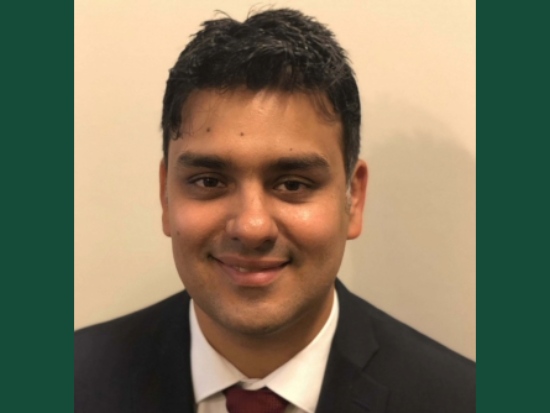 Transcranial Magnetic Stimulation (TMS) is an innovative therapy used to treat treatment-resistant depression (TRD) and obsessive-compulsive disorder (OCD). Unlike traditional therapies that rely on medications or invasive procedures, TMS offers a non-invasive approach that accurately targets specific brain regions affected by these conditions.
Transcranial Magnetic Stimulation (TMS) is an innovative therapy used to treat treatment-resistant depression (TRD) and obsessive-compulsive disorder (OCD). Unlike traditional therapies that rely on medications or invasive procedures, TMS offers a non-invasive approach that accurately targets specific brain regions affected by these conditions.
The Heersink Communications team sat with Abhishek Wadhwa, M.D., assistant professor in the UAB Department of Psychiatry and Behavioral Neurobiology, to learn more about TMS and its applications in treatment-resistant depression.
What is Transcranial Magnetic Stimulation, and how does it work in treating depression compared to traditional medications?
Wadhwa: Transcranial Magnetic Stimulation operates on Faraday’s principle of electromagnetic induction, which involves generating an electromagnetic field using magnetic coils. Electric pulses create a changing magnetic field at right angles to the coil, penetrating the scalp and skull and inducing an electric field in the brain. This process noninvasively and focally depolarizes neurons. The directly activated neurons trigger secondary neurons, influencing more distant sites in the brain.
Repetitive pulses or trains of pulses, known as "rTMS," have been demonstrated to provoke long-lasting, up-or-down regulation of synaptic activity, including in brain regions responsible for movement and emotion. This technique is based on the fundamental principle that brief stimulation periods can induce enduring changes in neuronal activity.
TMS is an outpatient procedure that is generally safe. The most commonly reported side effect is a headache at the stimulation site, while the most serious side effect, seizure, occurs at a low incidence rate of 1 in 30,000 treatments (0.003 percent).
When was TMS first introduced, and how has it developed as a treatment option for depression since then?
Wadhwa: TMS was developed in the early 1980s and emerged as a non-invasive and painless tool to probe brain function. Studies found that the stimulation induced long-lasting effects in neurons. In a groundbreaking randomized controlled crossover study, Pascual-Leone et al. demonstrated that high-frequency 10 Hz-rTMS of the left dorsolateral prefrontal cortex significantly decreased depression scores in patients with treatment-resistant major depression. This study paved the way for a large industry-sponsored trial by O’Reardon et al. (2007), which confirmed the antidepressant effects of rTMS and played a crucial role in its FDA approval for use in treatment-resistant depression in 2008. Two other large studies, sponsored by the NIH and industry (George et al., 2010; Levkovitz et al., 2015), further established TMS as a safe and effective treatment for treatment-resistant depression.
How do you determine if a patient is suitable for TMS therapy?
Wadhwa: TMS is currently approved for treating treatment-resistant depression, defined as an inadequate response to at least two antidepressants during the current depressive episode. A comprehensive psychiatric assessment is the first step in determining the effectiveness and safety of rTMS treatment. This assessment emphasizes obtaining a detailed medication history, evaluating for co-morbid conditions, and reviewing current medications, as these factors can influence treatment outcomes.
TMS is generally contraindicated for patients with metallic objects or implants near the head, including but not limited to cochlear implants, vagal nerve stimulators, aneurysm clips or coils, stents, bullet fragments, and other implanted electrodes or stimulators. Patients with a history of seizures must be on a stable treatment regimen before receiving TMS.
Under what circumstances would you recommend that a patient bring up TMS as a treatment option with their physician?
Wadhwa: Patients who continue to experience significant depression despite adhering to their medications or who cannot tolerate these medications should consider discussing TMS with their healthcare providers. Compared to other interventional treatments for depression, such as ECT or ketamine, TMS has the advantage of not imposing immediate restrictions on the patient's ability to drive or work after the procedure. Additionally, it does not require a "cool-down" period before resuming regular activities.
Can you explain the typical treatment process for TMS, including frequency and duration of sessions?
Wadhwa: TMS is a noninvasive, outpatient procedure consisting of an acute course of 20 to 30 treatment sessions over six weeks. Each session includes a physician's assessment and 20 minutes of active stimulation. The motor threshold is checked during the first session to determine the stimulus intensity and is reassessed regularly based on factors such as medication changes or poor treatment response.
The maintenance treatment course varies depending on the patient. Clinical benefits have been shown to last up to 12 months after the initial treatment course. Current treatment guidelines recommend gradually tapering the frequency of treatments while continually assessing the patient’s response and tolerability at each session.
How do you monitor the progress of a patient undergoing TMS therapy?
Wadhwa: Clinical evaluations and self-reported questionnaires, such as the PHQ-9, are administered at the pre-treatment baseline and during every treatment session to monitor progress and tolerability. For patients not under the direct management of a TMS physician, follow-up is conducted with their outpatient psychiatrists. A collaborative plan is established before treatment, detailing communication preferences for any health status or medication changes, as these may impact treatment outcomes.